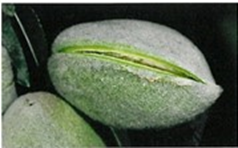Franz Niederholzer, UCCE Farm Advisor Colusa, Sutter and Yuba Counties
Dani Lightle, former UCCE Farm Advisor Glenn, Butte and Tehama Counties
Hull rot is a general term for hull infection by one of several pathogens. Infected nuts don’t shake off and must be removed by winter shaking and/or polling (winter sanitation), resulting in lost production plus increased management costs. In some varieties, especially Nonpareil, hull infections can spread to spurs and shoots, killing that wood and reducing future nut bearing sites.
There are two general types of hull rot infections, those that occur prior to hull split and those that occur after hull split. Monilinia and Phomopsis hull rot result from pre-hull split infection. Spray timings for both infections have passed. Rhizopus stolonifera and Aspergillus niger are wound pathogens that require an opening to enter and infect the hull. Hull split gives these pathogens an entry site to infect. Rhizopus hull rot is generally believed to be more widespread than Aspergillus niger hull rot and has been studied longer. Hence, we have a better understanding of what’s needed to manage Rhizopus stolonifera than Aspergillus niger hull rot.
The best, current approach to managing Rhizopus hull rot management includes three parts. The first two steps help to manage the environment, with respect to the disease triangle, while the latter seeks to control the pathogen.
- Moderate water stress in early hull split: The target is -14 to -18 bars stem water potential (SWP) measured using the pressure chamber for two or three weeks beginning just before ANY hull split (late June). The goal is to gradually reach this goal by reducing the hours of each irrigation set, not the number of irrigations. After 2 or 3 weeks at that moderate stress level, return irrigation to full ET. To hit that target, growers must start reducing irrigation at different dates, depending on the effective root zone and soil water holding capacity (texture). Growers with deeper loam and clay loam soils may need to begin to back off on irrigation as early as June 1, up to 30 days before expected HS. Growers on lighter, sandier ground, or with a shallow rootzone due to a hard pan, may be able to wait closer to HS before easing up on the water. The key to successful hull rot management with irrigation is getting the orchard to -14 to -18 bars just before the suture starts any separation and keeping it there for 2 weeks, then return to full ET irrigation. This moderate stress in a short period does not reduce yield and helps save on the energy bill. Use a pressure chamber (pressure bomb) to make sure water stress reaches the target on time but doesn’t exceed the target. If you don’t reach the target water stress before hull split, you won’t help control hull rot. If trees are severely stressed, next year’s yield potential can suffer. Pressure chamber information at: sacvalleyorchards.com/manuals/stem-water-potential/
- Careful nitrogen management. Adequate, but not excessive orchard N helps control hull rot. The target is <2.6% summer leaf N. Don’t apply N between May 15 and harvest in orchards with hull rot history.
- Spray application:
Fungicides. To control Rhizopus hull rot with fungicides, the best spray timing is early hull split (Stage 2C) – the same as for first NOW spray. FRAC group fungicides 3 (not all), 11, and 19 provide “good and reliable” control when carefully applied. Check UC Fungicide Efficacy and Timing publication for specific fungicide efficacy information (ipm.ucanr.edu/PDF/PMG/fungicideefficacytiming.pdf)
Stage 2C of hull split. When sound nuts in the SW corner of tree tops look like this, this is THE critical timing for insecticide for navel orangeworm and fungicide for Rhizopus hull rot. When all the trees in the orchard have all the nuts that look at least like this from top to bottom, the orchard should be ready to harvest.
Alkaline products. In several years of research trials by Dr. Jim Adaskaveg (UC Riverside), foliar sprays of some alkaline fertilizer/nutritional products reduced hull rot strikes per tree as much as many fungicides when sprayed at the same hull split timing. Effective materials in Dr. Adaskaveg’s tests include K2PO4 fertilizer and Cinetis® (kelp extract plus mono-ammonium phosphate). There was no additive increase in hull rot control when fungicides were tank mixed with alkaline materials. Dr. Adaskaveg believes that the alkaline materials may neutralize the toxin produced by the hull rot infections responsible for spur and shoot death. Note: These fertilizer products are not registered as pesticides and so may not be specifically prescribed for hull rot control.


Leave a Reply